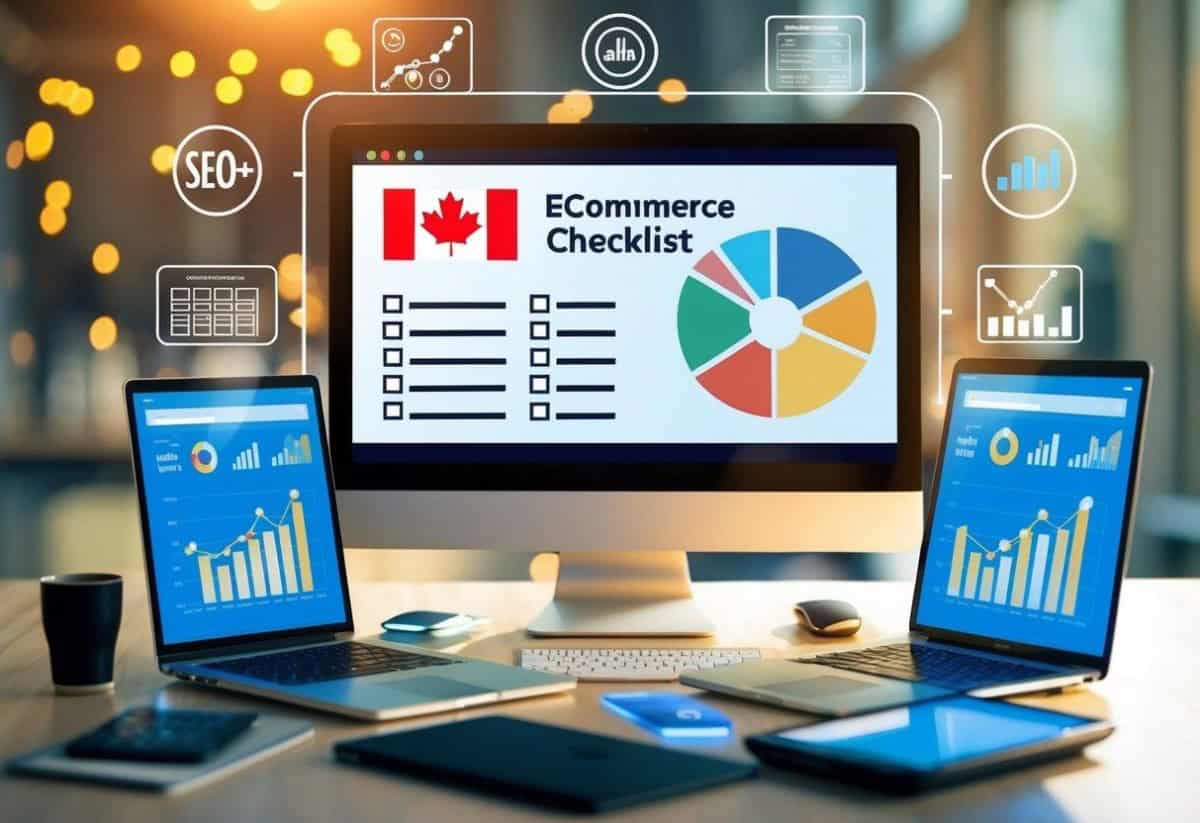
Are you ready to boost your online store’s visibility and sales? As a Canadian e-commerce business owner, I know how crucial it’s to stand out in the crowded digital marketplace. A well-planned SEO strategy with a top SEO company can make all the difference in getting your products in front of eager shoppers.
I’ve compiled a handy checklist to help you nail your e-commerce SEO game. This guide covers everything from the basics of setting up Google Analytics to advanced tactics for optimizing product pages. You’ll find actionable tips to improve your search rankings, whether you’re just starting or looking to fine-tune your existing strategy.
Let’s dive into the key areas you need to focus on to make your Canadian online store shine. We’ll look at on-page optimization, technical SEO, and off-page elements that can give you an edge over the competition. By the end of this post, you’ll have a clear roadmap to SEO success for your e-commerce site.
Key Takeaways
- Set up analytics and choose the right SEO tools for your e-commerce site
- Create unique product descriptions and optimize your site structure
- Build quality backlinks and track your SEO performance regularly
Getting Started With E-commerce SEO

SEO helps online stores show up in search results and get more customers. I’ll explain the basics, how to find good keywords, and which tools can help you succeed.
Understanding SEO Fundamentals
SEO means making your website easy for search engines to find and understand. It’s about using the right words, making your site fast, and having good content. Search engines look at things like how many people visit your site and how long they stay.
They also check if other sites link to yours. To do well, you need to make your site work well on phones and computers. You should also use clear titles and descriptions for your pages. This helps search engines know what your pages are about.
The Importance of Keyword Research
Keyword research helps you find words people use when they search online. It’s key to getting the right visitors to your site. I use tools like Google Keyword Planner to find keywords with good search volume.
Long-tail keywords are longer phrases that fewer people search for. But they can be great for bringing in buyers who know what they want. I also look for informational keywords. These help me make content that answers people’s questions. This can build trust and bring more people to my site.
Setting Up Tools for SEO Success
I use several tools to track how well my site is doing. Google Search Console shows me which of my pages show up in searches and how often people click on them. Google Analytics tells me about the people who visit my site.
It shows where they come from and what they do on my site. SEMrush and Ahrefs are paid tools that give more detailed info. They help me find keyword ideas and see how I’m doing compared to other sites. These tools also show me which sites link to mine, which is important for SEO.
On-Page Optimization for E-commerce
On-page optimization is key for e-commerce success. I’ll cover the most important elements to boost your online store’s visibility and sales.
Crafting Quality Meta Data
Meta data helps search engines understand my pages. I start with title tags, keeping them under 60 characters and including my main keyword. For product pages, I add the brand and model number. Meta descriptions should be 150-160 characters and include a call-to-action.
I use schema markup to give search engines more info about my products. This can show price, availability, and reviews right in search results. It’s a bit technical, but there are plugins that make it easier.
For URLs, I keep them short and include my target keyword. A good format is: mystore.ca/category/product-name
Enhancing User Experience
A good user experience is crucial for SEO and sales. I make sure my site loads fast by compressing images and using a good host. Google’s Core Web Vitals are important metrics to watch.
My site needs to work well on mobile devices. I use a responsive design that adjusts to different screen sizes. Buttons and links should be easy to tap on smartphones.
Navigation is key. I use clear categories and a search bar to help shoppers find products. Breadcrumbs show users where they are on my site.
Optimizing Product and Category Pages
My product pages need detailed, unique descriptions. I focus on benefits and features, using keywords naturally. Customer reviews add fresh content and build trust.
I use high-quality images and optimize them for fast loading. Alt text on images helps with SEO and accessibility.
For category pages, I add some text to describe the products. This gives me a chance to use keywords and provide useful info to shoppers.
Internal linking is important. I link related products and categories to help users and search engines explore my site.
Technical SEO and Site Structure

Technical SEO and site structure are key to helping search engines find and understand your e-commerce site. I’ll cover how to build a solid site architecture and improve your site’s speed and performance.
Building a Solid Site Architecture
A good site structure helps both users and search engines navigate your site easily. I recommend using a flat site structure with no more than 3 clicks from the homepage to any product page.
Create a clear menu with your main product categories. Use breadcrumbs to show the path back to the homepage. This helps users find their way around.
Internal linking is vital. Link between related products and categories. This spreads link equity and helps search engines crawl your site.
Make a sitemap and submit it to Google Search Console. This helps Google find and index all your pages. Don’t forget your robots.txt file. It tells search engines which pages to crawl or not crawl.
Check for broken links and fix them right away. Broken links hurt user experience and waste crawl budget.
Improving Site Speed and Performance
Site speed is crucial for SEO and user experience. Slow sites lose sales and rank poorly in search results.
Use Google PageSpeed Insights to check your site speed. It gives tips to make your site faster.
Compress images before uploading them. Large images slow down page load times. Use next-gen formats like WebP for even better results.
Enable browser caching. This stores parts of your site on users’ devices, so pages load faster on repeat visits.
Minimize HTTP requests by combining files where possible. Each request takes time, so fewer requests mean faster load times.
If your site is slow, think about changing your web host or using a content delivery network (CDN). These can speed up your site a lot.
Off-Page Elements and Performance Tracking

Off-page SEO is key for Canadian e-commerce success. It boosts visibility and brings more shoppers to your site. Tracking how well these efforts work is just as important.
Strategies for Effective Link Building
I’ve found that getting good links is crucial for off-page SEO. I do this by making great content that others want to link to. I also reach out to other sites in my niche to build relationships. Guest posting on respected blogs can work well, too.
Another tactic I use is finding mentions of my brand without links and asking for them to be added. I also make sure to create and keep up-to-date profiles on business directories. Social media is handy for sharing content and getting more eyes on it, which can lead to natural links.
Measuring SEO Success
I monitor several metrics to determine whether my off-page work is paying off. I check my rankings for key terms in Google search results, which shows whether I’m moving up or down.
I also monitor my website traffic from search engines. More visits usually mean my SEO is working. I also monitor my click-through rate. If it’s going up, my listings are likely more appealing.
I track how many backlinks I’m getting and their quality. Tools like Ahrefs or Moz can help with this. Lastly, I look at conversions. After all, the goal is to turn visitors into customers. If conversions are up, it’s a good sign my SEO efforts are paying off.
Daniel Raymond, a project manager with over 20 years of experience, is the former CEO of a successful software company called Websystems. With a strong background in managing complex projects, he applied his expertise to develop AceProject.com and Bridge24.com, innovative project management tools designed to streamline processes and improve productivity. Throughout his career, Daniel has consistently demonstrated a commitment to excellence and a passion for empowering teams to achieve their goals.